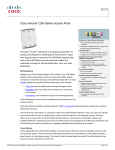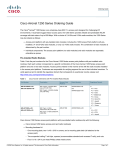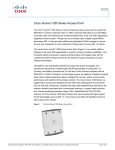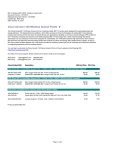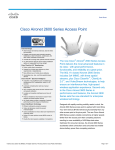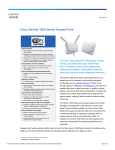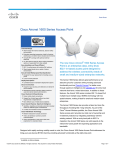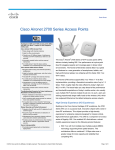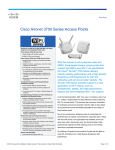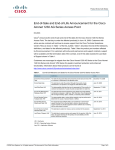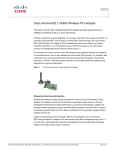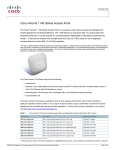Download Cisco 802.11a/g/n-draft 2.0 2.4/5-GHz Modular Autonomous AP, 6 RP-TNC, FCC
Transcript
. Data Sheet Cisco Aironet 1250 Series Access Point Performance with Investment Protection ● Up to nine times faster than 802.11a/g networks ● Backward-compatible with 802.11a/b/g clients ● M-Drive technology optimizes RF Flexible Platform ● Versatile RF coverage with external antennas ● Supports both 2.4-GHZ and 5-GHz modules ® ® The Cisco Aironet 1250 Series is a rugged indoor access point designed for challenging RF environments that require the antenna versatility associated with connectorized antennas, a rugged metal enclosure, and a broad operating temperature range. The first enterprise-class access point to support the IEEE 802.11n draft 2.0 standard, it offers combined data rates of up to 600 Mbps to provide users with mobile access to high-bandwidth data, voice, and video applications. 802.11n provides reliable and predictable WLAN coverage to improve the end-user experience for both existing 802.11a/b/g clients and new 802.11n clients. As part of the Cisco Unified Wireless Network, the 1250 Series provides the industry’s lowest total cost of ownership and investment protection by integrating seamlessly with the existing network. With a Gigabit Ethernet Rugged Metal Housing and Extended Operating Temperature ● Ideal for factories, warehouses, and other industrial environments ● UL 2043 plenum rated for above ceiling installation options or suspended from drop ceilings Secure Interoperability ● 802.11n draft 2.0 compliant ● Intel Connect with Centrino Certified Simplified Network Management ● Controller-based or standalone deployment options ● CleanAir* technology reduces troubleshooting and performance impacts Secure Connections ● Supports rogue access point detection and denial of service attacks ● Management frame protection detects malicious users and alerts network administrators Greater Network Capacity ● Dynamic frequency selection 2 (DFS-2) compliant (10/100/1000) interface, the Cisco Aironet 1250 Series offers the flexibility of inline as well as local power options. RF Excellence The Cisco Unified Wireless Network with M-Drive technology removes the mystery associated with design, implementation, and ongoing optimization of enterprise wireless networks. With Cisco M-Drive technology, IT has the tools needed to build and operate a high-performance wireless network without the need for extensive RF engineering skills. Cisco M-Drive technology is a systemwide approach that manages the corporate RF spectrum, improves wireless coverage, and increases system capacity and performance. Features include: ● Radio resource management (RRM): Automated self-healing optimizes RF to reduce unpredictability and dead spots and to help ensure high-availability client connections. RRM optimizes network capacity and mitigates interference by continuously monitoring and adjusting access point power and channel settings and then load balancing clients to enhance wireless coverage. © 2009 Cisco Systems, Inc. All rights reserved. This document is Cisco Public Information. Page 1 of 8 Data Sheet ● CleanAir technology: Only Cisco offers a comprehensive solution to detect, classify, locate, and mitigate sources of interference, including non-Wi-Fi sources such as Bluetooth, microwave ovens, cordless phones, and more. With the ability to visualize performance-impacting interference directly from the Cisco Wireless Control System (WCS), you can proactively manage the challenges of a shared wireless spectrum and optimize network performance. Power Options The Cisco Aironet 1250 Series Access Point can be powered by a Cisco Ethernet switch, a power injector, or a local power supply. The number of radio modules determines which Cisco Ethernet switch can power the Aironet 1250 Series Access Point. Powering the Aironet 1250 Series Access Point with 802.3af Power over Ethernet The Aironet 1250 Series Access Point with one RM1252 radio module installed requires 12.95W, which is within the 802.3af Power over Ethernet (PoE) standard. Any Cisco switch supporting 802.3af may be used to power the Aironet 1250 Series Access Point with one RM1252 radio module installed. This is ideal for businesses that chose to only deploy on a single frequency (2.4 GHz or 5 GHz). A single radio provides optimum performance with approximately 300 Mbps maximum PHY data rate. Customers who deploy dual-band, 802.11n radios and power the 1250 Series using standard 802.3af will have more reliable and predictable coverage than that provided by traditional 802.11a/g networks; however, operation will be limited to a single transmitter per radio with maximum PHY data rates of 150 Mbps instead of 300 Mbps per radio. Customers with a significant investment in 802.11 a/b/g client devices that have low-to-medium bandwidth needs but high-reliability requirements will benefit the most from this type of deployment scenario. Powering the Aironet 1250 Series Access Point with Cisco Enhanced PoE Cisco Enhanced PoE was designed for customers who want to install new PoE-enabled technologies that require greater than 15.4W per port to function at full capability, such as wireless technology based on the IEEE 802.11n standard. Cisco Enhanced PoE provides the full power requirements for dual-radio modules and eliminates the need to run an additional cabling drop or insert a separate power injector. Support for Enhanced PoE is currently available ® on a variety of Cisco Catalyst switching platforms. For more information on Enhanced PoE, visit http://www.cisco.com/en/US/prod/switches/epoe.html. Product Specifications Table 1 lists the product specifications for Cisco Aironet 1250 Series Access Points. Table 1. Product Specifications for Cisco Aironet 1250 Series Access Points Item Specification Part Numbers Access point platform with pre-installed radio modules: ● AIR-AP1252AG-x-K9 802.11a/g/n-draft 2.0 2.4/5-GHz Modular Autonomous AP; 6 RP-TNC ● AIR-AP1252G-x-K9 802.11g/n-draft 2.0 2.4-GHz Modular Autonomous AP; 3 RP-TNC ● AIR-LAP1252AG-x-K9 802.11a/g/n-draft 2.0 2.4/5-GHz Modular Unified AP; 6 RP-TNC ● AIR-LAP1252G-x-K9 802.11g/n-draft 2.0 2.4-GHz Modular Unified AP; 3 RP-TNC Individual components: ● AIR-AP1250= Modular Auto AP Platform (no radio modules); Spare ● AIR-LAP1250= Modular Unified AP Platform (no radio modules); Spare ● AIR-RM1252A-x-K9= 802.11a/n-d2.0 5-GHz Radio Module; 3 RP-TNC ● AIR-RM1252G-x-K9= 802.11g/n-d2.0 2.4-GHz Radio Module; 3 RP-TNC ● AIR-AP1250MNTGKIT= 1250 Series Ceiling, Wall Mount Bracket kit- Spare ● AIR-LAP1252-x-K9-5 Eco-pack 802.11a/g/n 2.4/5 GHz Mod Unified AP, FCC, 5 APs Regulatory domains: (x = regulatory domain) Customers are responsible for verifying approval for use in their individual countries. To verify approval and to identify the regulatory domain that corresponds to a particular country, please visit http://www.cisco.com/go/aironet/compliance. © 2009 Cisco Systems, Inc. All rights reserved. This document is Cisco Public Information. Page 2 of 7 Data Sheet Item Specification Not all regulatory domains have been approved. As they are approved, the part numbers will be available on the Global Price List. ® Software ● Cisco IOS Software Release 12.4(10b)JA or later (Autonomous Mode). ● Cisco IOS Software Release 12.4(10b)JX or later (Unified Mode). ● Cisco Unified Wireless Network Software Release 4.2 or later. Draft 802.11n Version 2.0 (and Related) Capabilities ● 2x3 MIMO with two spatial streams ● Maximal Ratio Combining (MRC) ● 20-and 40-MHz channels ● PHY data rates up to 300 Mbps ● Packet aggregation: A-MPDU (Tx/Rx), A-MSDU (Tx/Rx) ● 802.11 DFS (Bin 5) ● Cyclic Shift Diversity (CSD) support Data Rates Supported 802.11a: 6, 9, 12, 18, 24, 36, 48, and 54 Mbps 802.11g: 1, 2, 5.5, 6, 9, 11, 12, 18, 24, 36, 48, and 54 Mbps 802.11n data rates (2.4 GHz and 5 GHz): MCS Index1 Frequency Band and 20-MHz Operating Channels 2 GI = 800ns GI = 400ns 20-MHz Rate (Mbps) 40-MHz Rate (Mbps) 20-MHz Rate (Mbps) 40-MHz Rate (Mbps) 0 6.5 13.5 7.2 15 1 13 27 14.4 30 2 19.5 40.5 21.7 45 3 26 54 28.9 60 4 39 81 43.3 90 5 52 108 57.8 120 6 58.5 121.5 65 135 7 65 135 72.2 150 8 13 27 14.4 30 9 26 54 28.9 60 10 39 81 43.3 90 11 52 108 57.8 120 12 78 162 86.7 180 13 104 216 115.6 240 14 117 243 130 270 15 130 270 144.4 300 -A (Americas (FCC)): ● 2.412 to 2.462 GHz; 11 channels ● 5.180 to 5.320 GHz; 8 channels ● 5.500 to 5.700 GHz, 8 channels (excludes 5.600 to 5.640 GHz) ● 5.745 to 5.825 GHz; 5 channels -C (China): ● 2.412 to 2.472 GHz; 13 channels ● 5.745 to 5.825 GHz; 5 channels -E (ETSI): ● 2.412 to 2.472 GHz; 13 channels ● 5.180 to 5.320 GHz; 8 channels ● 5.500 to 5.700 GHz, 11 -K (Korea): ● 2.412 to 2.472 GHz; 13 channels ● 5.180 to 5.320 GHz; 8 channels ● 5.500 to 5.620 GHz, 7 channels ● 5.745 to 5.805 GHz, 4 channels -N (Non-FCC): ● 2.412 to 2.462 GHz; 11 channels ● 5.180 to 5.320 GHz; 8 channels ● 5.745 to 5.825 GHz; 5 channels -P (Japan2): ● 2.412 to 2.472 GHz; 13 channels ● 5.180 to 5.320 GHz; 8 channels -S (Singapore): ● 2.412 to 2.472 GHz; 13 channels ● 5.180 to 5.320 GHz; 8 channels 1 MCS Index: The Modulation and Coding Scheme (MCS) index determines the number of spatial streams, the modulation, the coding rate, and data rate values. GI: A Guard Interval (GI) between symbols helps receivers overcome the effects of multipath delays. 2 © 2009 Cisco Systems, Inc. All rights reserved. This document is Cisco Public Information. Page 3 of 7 Data Sheet Item Specification ● 5.745 to 5.825 GHz; 5 channels channels -I (Israel): ● 2.412 to 2.472 GHz, 13 channels ● 5.180 to 5.320 GHz; 8 channels -T (Taiwan): ● 2.412 to 2.462 GHz; 11 channels ● 5.280 to 5.320 GHz; 3 channels ● 5.500 to 5.700 GHz, 11 channels ● 5.745 to 5.825 GHz; 5 channels Note: This varies by regulatory domain. Refer to the product documentation for specific details for each regulatory domain. Maximum Number of NonOverlapping Channels 2.4 GHz ● 802.11b/g: 5 GHz ● 802.11a: ◦ 20 MHz: 3 ● 802.11n: ◦ 20 MHz: 21 ● 802.11n: ◦ 20 MHz: 3 ◦ 20 MHz: 21 ◦ 40 MHz: 1 ◦ 40 MHz: 9 Note: This varies by regulatory domain. Refer to the product documentation for specific details for each regulatory domain. Receive Sensitivity Maximum Transmit Power 802.11b 802.11g 802.11a –90 dBm @ 1 Mb/s –87 dBm @ 6 Mb/s –86 dBm @ 6 Mb/s –89 dBm @ 2 Mb/s –86 dBm @ 9 Mb/s –85 dBm @ 9 Mb/s –87 dBm @ 5.5 Mb/s –83 dBm @ 12 Mb/s –82 dBm @ 12 Mb/s –85 dBm @ 11 Mb/s –82 dBm @ 18 Mb/s –81 dBm @ 18 Mb/s –81 dBm @ 24 Mb/s –80 dBm @ 24 Mb/s –80 dBm @ 36 Mb/s –79 dBm @ 36 Mb/s –75 dBm @ 48 Mb/s –74 dBm @ 48 Mb/s –74 dBm @ 54 Mb/s –73 dBm @ 54 Mb/s 2.4-GHz 2.4-GHz 5-GHz 802.11n (HT20) 802.11n (HT40) 802.11n (HT20) 802.11n (HT40) –86 dBm @ MC0 –86 dBm @ MC0 –85 dBm @ MC0 –85 dBm @ MC0 –85 dBm @ MC1 –85 dBm @ MC1 –84 dBm @ MC1 –84 dBm @ MC1 –84 dBm @ MC2 –84 dBm @ MC2 –83 dBm @ MC2 –83 dBm @ MC2 –83 dBm @ MC3 –80 dBm @ MC3 –82 dBm @ MC3 –79 dBm @ MC3 –80 dBm @ MC4 –77 dBm @ MC4 –79 dBm @ MC4 –76 dBm @ MC4 –75 dBm @ MC5 –72 dBm @ MC5 –74 dBm @ MC5 –71 dBm @ MC5 –74 dBm @ MC6 –71 dBm @ MC6 –73 dBm @ MC6 –70 dBm @ MC6 –73 dBm @ MC7 –70 dBm @ MC7 –72 dBm @ MC7 –69 dBm @ MC7 –86 dBm @ MC8 –86 dBm @ MC8 –85 dBm @ MC8 –85 dBm @ MC8 –85 dBm @ MC9 –85 dBm @ MC9 –84 dBm @ MC9 –84 dBm @ MC9 –84 dBm @ MC10 –84 dBm @ MC10 –83 dBm @ MC10 –83 dBm @ MC10 –83 dBm @ MC11 –80 dBm @ MC11 –82 dBm @ MC11 –79 dBm @ MC11 –80 dBm @ MC12 –77 dBm @ MC12 –79 dBm @ MC12 –76 dBm @ MC12 –75 dBm @ MC13 –72 dBm @ MC13 –74 dBm @ MC13 –71 dBm @ MC13 –74 dBm @ MC14 –71 dBm @ MC14 –73 dBm @ MC14 –70 dBm @ MC14 –73 dBm @ MC15 –70 dBm @ MC15 –72 dBm @ MC15 –69 dBm @ MC15 2.4GHz ● 802.11b 5-GHz 5GHz ● 802.11a ◦ 23 dBm with 1 antenna ● 802.11g ◦ 17 dBm with 1 antenna ● 802.11n non-HT duplicate (802.11a duplicate) mode ◦ 20 dBm with 1 antenna ● 802.11n (HT20) ◦ 17 dBm with 1 antenna ● 802.11n (HT20) ◦ 17 dBm with 1 antenna ◦ ◦ 20 dBm with 2 antennas ◦ ● 802.11n (HT40) 17 dBm with 1 antenna 20 dBm with 2 antennas ● 802.11n (HT40) ◦ 17 dBm with 1 antenna ◦ 17 dBm with 1 antenna ◦ 20 dBm with 2 antennas ◦ 20 dBm with 2 antennas Note: The maximum power setting will vary by channel and according to individual country regulations. Refer to the product documentation for specific details. © 2009 Cisco Systems, Inc. All rights reserved. This document is Cisco Public Information. Page 4 of 7 Data Sheet Item Specification Available Transmit Power Settings 2.4GHz 5GHz 23 dBm (200 mW) 20 dBm (100 mW) 20 dBm (100 mW) 17 dBm (50 mW) 17 dBm (50 mW) 14 dBm (25 mW) 14 dBm (25 mW) 11 dBm (12.5 mW) 11 dBm (12.5 mW) 8 dBm (6.25 mW) 8 dBm (6.25 mW) 5 dBm (3.13 mW) 5 dBm (3.13 mW) 2 dBm (1.56 mW) 2 dBm (1.56 mW) –1 dBm (0.78 mW) –1 dBm (0.78 mW) Note: The maximum power setting will vary by channel and according to individual country regulations. Refer to the product documentation for specific details. Antenna Connectors ● 2.4-GHz: 3 RP-TNC connectors ● 5-GHz: 3 RP-TNC connectors Interfaces ● 10/100/1000BASE-T autosensing (RJ-45) ● Management console port (RJ45) Indicators ● Status LED indicates operating state, association status, error/warning condition, boot sequence, and maintenance status. ● Ethernet LED indicates activity over the Ethernet, status. Modularity ● Number of radio module slots: 2 ● Available radio modules ● Radio LED indicates activity over the radio, status. Part Number Description Maximum per AP1250 platform AIR-RM1252A-x-K9 2.4 802.11a/n-d2.0 5-GHz Radio Module; 3 RP-TNC 1 AIR-RM1252G-x-K9 802.11g/n-d2.0 2.4-GHz Radio Module; 3 RPTNC 1 Dimensions (W x L x H) ● AP (without mounting bracket): 8.12 x 9.52 x 2.35 in. (20.62 x 24.18 x 5.97 cm) ● AP (with mounting bracket): 8.12 x 9.52 x 2.75 in. (20.62 x 24.18 x 6.99 cm) Weight ● AP with 2 radios installed: 5.1 lbs (2.31 kg) ● AP chassis: 2.1 lbs (0.95 kg) ● 2.4 GHz radio: 1.5 lbs (0.68 kg) ● 5 GHz radio: 1.5 lbs (0.68 kg) Environmental Nonoperating (storage) temperature: –40 to 185°F (–40 to 85°C) Operating temperature: –4 to +131°F (–20 to +55°C) Operating humidity: 10 to 90 percent (noncondensing) System Memory ● 64 MB DRAM ● 32 MB flash Input Power Requirements ● AP1250: 36 to 57 VDC ● Power Supply and Power Injector: 100 to 240 VAC; 50 to 60 Hz Powering Options ● Cisco Catalyst switch port capable of sourcing 20W or greater ● Cisco AP1250 Power Injector (AIR-PWRINJ4) ● Cisco AP1250 Local Power Supply (AIR-PWR-SPLY1) ● 802.3af switch (AP1250 with single radio only) Power Draw ● AP1250 with two RM1252 radio modules installed: 18.5W ● AP1250 with one RM1252 radio module installed: 12.95W Note: For a 1250 Series Access Point with two radios, 18.5W is the maximum power required at the access point (powered device). When deployed using PoE, the power drawn from the power sourcing equipment will be higher by some amount dependent on the length of the interconnecting cable. This additional power may be as high as 1.5W, bringing the total system power draw (access point + cabling) to 20W. A similar consideration applies for a 1250 Series Access Point with one radio. Warranty 90 days © 2009 Cisco Systems, Inc. All rights reserved. This document is Cisco Public Information. Page 5 of 7 Data Sheet Item Specification Compliance Standards ● Safety: ◦ UL 60950-1 ◦ CAN/CSA-C22.2 No. 60950-1 ◦ UL 2043 ◦ IEC 60950-1 ◦ EN 60950-1 ● Radio approvals: ◦ FCC Part 15.247, 15.407 ◦ RSS-210 (Canada) ◦ EN 300.328, EN 301.893 (Europe) ◦ ARIB-STD 33 (Japan) ◦ ARIB-STD 66 (Japan) ◦ ARIB-STD T71 (Japan) ◦ AS/NZS 4268.2003 (Australia and New Zealand) ◦ EMI and susceptibility (Class B) ◦ FCC Part 15.107 and 15.109 ◦ ICES-003 (Canada) ◦ VCCI (Japan) ◦ EN 301.489-1 and -17 (Europe) ◦ EN 60601-1-2 EMC requirements for the Medical Directive 93/42/EEC ● IEEE Standard ◦ IEEE 802.11a/b/g, IEEE 802.11n draft 2.0, IEEE 802.11h, IEEE 802.11d ● Security: ◦ 802.11i, Wi-Fi Protected Access 2 (WPA2), WPA ◦ 802.1X ◦ Advanced Encryption Standards (AES), Temporal Key Integrity Protocol (TKIP) ● EAP Type(s): ◦ Extensible Authentication Protocol-Transport Layer Security (EAP-TLS) ◦ EAP-Tunneled TLS (TTLS) or Microsoft Challenge Handshake Authentication Protocol Version 2 (MSCHAPv2) ◦ Protected EAP (PEAP) v0 or EAP-MSCHAPv2 ◦ Extensible Authentication Protocol-Flexible Authentication via Secure Tunneling (EAP-FAST) ◦ PEAPv1 or EAP-Generic Token Card (GTC) ◦ EAP-Subscriber Identity Module (SIM) ● Multimedia: ◦ Wi-Fi Multimedia (WMM™) ● Other: ◦ FCC Bulletin OET-65C ◦ RSS-102 Service and Support Cisco and Cisco Wireless LAN Specialized Partners offer a broad portfolio of end-to-end services based on proven methodologies for planning, designing, implementing, operating, and optimizing the performance of a variety of secure voice and data wireless network solutions, technologies, and strategies. Cisco Wireless LAN Specialized Partners bring application expertise to help deliver a secure enterprise mobility solution with a low total cost of ownership. For more information about Cisco 802.11n planning and deployment services, visit http://www.cisco.com/go/wirelesslanservices. For More Information For more information about the Cisco Aironet 1250 Series, visit http://www.cisco.com/go/wireless or contact your local account representative. © 2009 Cisco Systems, Inc. All rights reserved. This document is Cisco Public Information. Page 6 of 7 Data Sheet Printed in USA © 2009 Cisco Systems, Inc. All rights reserved. This document is Cisco Public Information. C78-423375-05 05/09 Page 7 of 7







